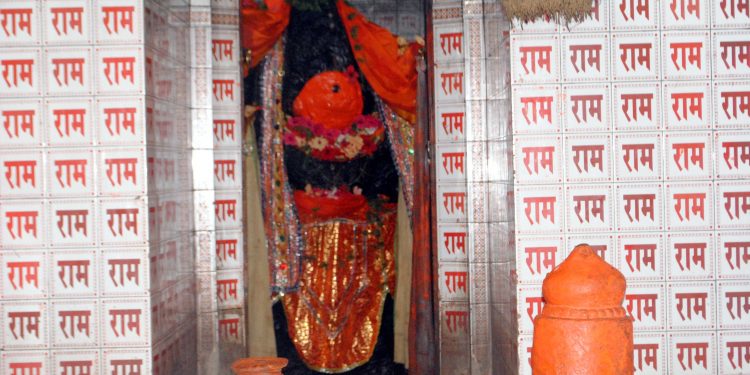Lord Hanuman, who stands for strength, courage, selflessness and righteous conduct, is also known as the greatest devotee of Lord Rama. He is believed to be among the seven immortal living beings in the Hindu pantheon who will live until the end of Kali Yuga. But not many are familiar with the lesser known story about Hanuman’s bond with Lord Jagannath. In Odia literature, Shree Jagannath is widely accepted as Avatari (incarnator) and ten others (Dasa Avatara), including Lord Rama and Lord Krishna, are his incarnations (Avatars). Saint Tulsidas, an ardent devotee of Lord Rama, also accepted Shree Jagannath as Shree Rama during his visit to Puri, according to religious texts. No wonder, Hanuman (Mahavir), the greatest Rama-bhakt, continues to protect the abode of Lord Jagannath. Though there are many Hanuman temples in Puri district, the one at Siruli is unique. With just a couple of days to go before this year’s Rath Yatra, Sunday POST explores the connection between Hanuman at Siruli and Lord Jagannath.
Located about 27 km north east of Puri town, Siruli Mahavir is a small temple. Legend has it that after defeating Ravana, Lord Rama returned to Ayodhya and was anointed king. It was then that Hanuman set out on a pilgrimage and visited Jagannath Temple at Puri. While returning from Puri, he saw a beautiful pond full of lotus flowers and decided to offer his evening prayers there. Siruli Hanuman Temple is located at the spot where Hanuman offered his prayers.
Describing the history of the temple, Siruli Mahavir Jayanti Trust president Ramesh Chandra Pradhan says, “It was set up in the 12th century by Puri King Anangabhima Dev II. Lord Jagannath had engaged Hanuman to guard Srimandir at Puri. It is said that Hanuman’s snoring disturbed Goddess Lakshmi’s sleep. So, she complained to Lord Jagannath who asked his guard to shift two and a half feet back and Hanuman shifted to Siruli. King Anangabhima Dev II in his dream saw Lord Jagannath asking him to erect a temple at Siruli. So, he constructed the temple and appointed servitors to worship the idol of Hanuman.”
According to another legend, when Lord Hanuman was going to Siruli, his long tail was hurt by the plough of a farmer. The farmer was tilling his land when he saw blood oozing out from his plough and he became unconscious. Lord Jagannath asked him to set up a temple for Hanuman on the very spot. Devotees started flocking in huge numbers to see the long tail of Lord Hanuman at Kandagoda village.
Another interesting aspect of the Hanuman idol at the Siruli temple is that the left eye looks towards Jagannath temple of Puri and the right eye is set to the south towards Ravana’s kingdom Lanka. The idol is made of black chlorite and its height is about 10 feet. The deity exhibits Lord Rama and Sita in his pierced heart. A Shivalinga, canopied by a seven hooded serpent, is placed above the head of the presiding deity. Locals say one can see the Neela Chakra atop Puri Jagannath Temple through the hole of Hanuman’s left eye.
Hanuman’s idol is seen holding the Gandhamardana mountain in his right hand while his left hand holds a katuri or short dagger. He wears a garland of gems (Vaijayantimala). A sculpture of Anjana, Hanuman’s mother, is carved to the right of the pedestal. Though the temple does not hold much importance from the architectural point of view, from the religious angle, it is one of the most sacred shrines in Odisha.
Temple servitor Nabakishore Mohapatra says, “This temple consists of four structures, the Vimana, Jagamohana, Natamandapa and Bhogamandapa. The temple is made of laterite and sandstone locally called mankada and kanda patharas, respectively. The Vimana’s height is about 25 feet and its base is square. It is erected on a two-feet high platform. The Jagamohana of the temple is apidha deula and its height is about 20 feet. The base of the Jagamohana is rectangular measuring 20 feet in length and 10 feet in width. The Bhogamandapa of the temple is a pidha deula and its height is about 18 feet from the surface of the temple complex. The base of the structure is rectangular measuring 40 feet in length and 20 feet in width. The Natamandapa of the temple with a flat roof supported by 10 pillars was constructed in the modern period. Two huge lions are installed on both sides of the main entrance. The outer walls of the main temple contain figures of Hanuman, Ganesha, Mahisasuramardini Durga, Siva Linga and bull. The figures of the nine planets (nabagrahas) are carved above the eastern entrance of the temple. There is an old peepal tree in front of the temple.”
He adds: “The figures of Nandi and Bhrungi are depicted on the walls of the porch hall inside the main entrance and they act as the gatekeepers of the temple. Hanuman is a devotee of Lord Rama, an incarnation of Lord Jagannath. So, there is no difference between Lord Rama and Lord Jagannath.”
Historian Naresh Dash says, “The Jagannath temple is protected by Hanuman from all the directions. Srimandir has four gates. There are Asta Hanuman or Mahaviras engaged in protecting the Puri Dhama. They are Siddha Mahavira, Daria Mahavira or Bedi Mahavira, Kanapata Mahavira, Vargi Mahavira, Masani Mahavira, Pancha Mukhi Mahavira, and Phate Mahavira. At the Lion’s Gate is Phate Hanuman, at the western gate is Vira Vikrama Hanuman, at the northern gate Tapasvi Hanuman and at the southern gate Kanapata Hanuman and Bada Bhai Hanuman. There is a tradition at Siruli Mahavira where devotees offer flowers used for adornment of Lord Jagannath at Srimandir and get their wishes fulfilled.”
RASHMI REKHA DAS, OP






































